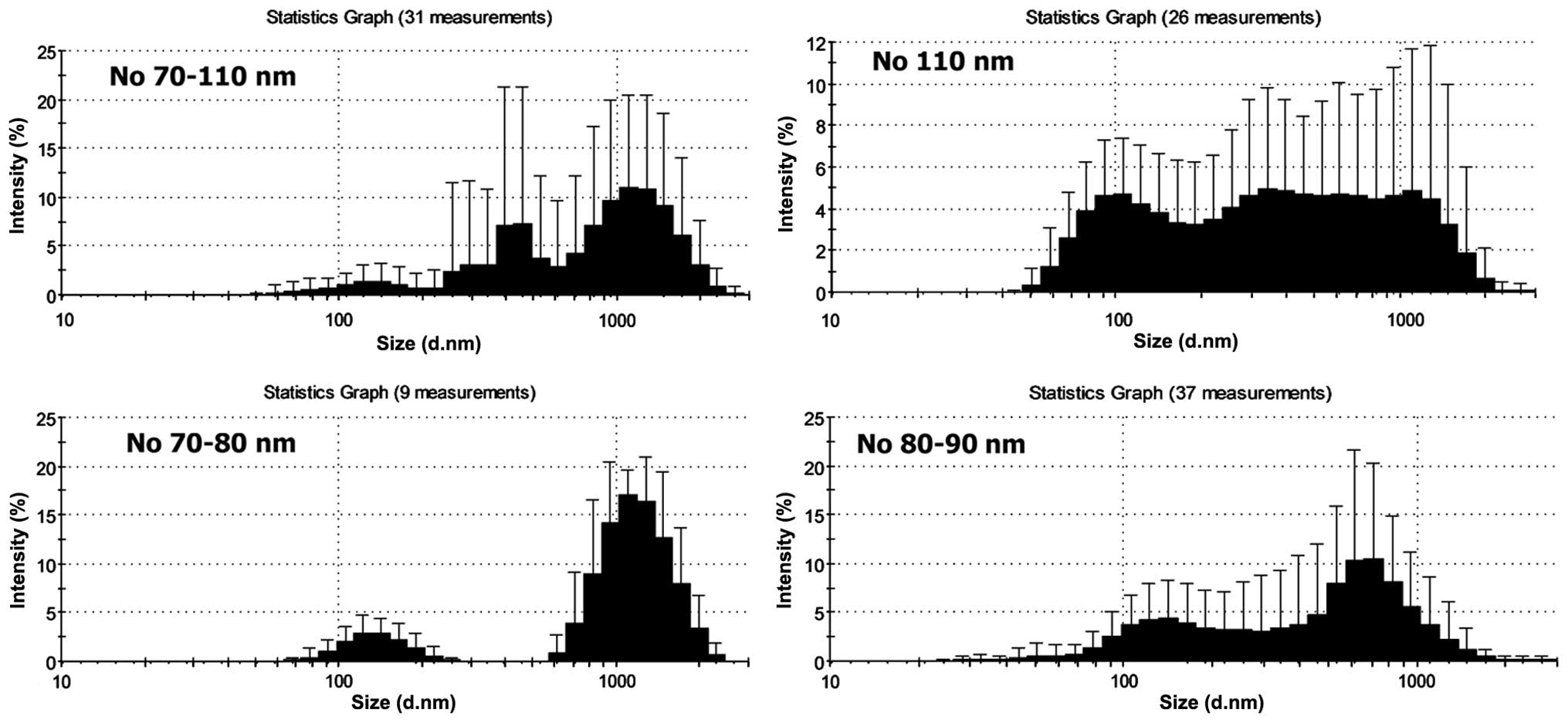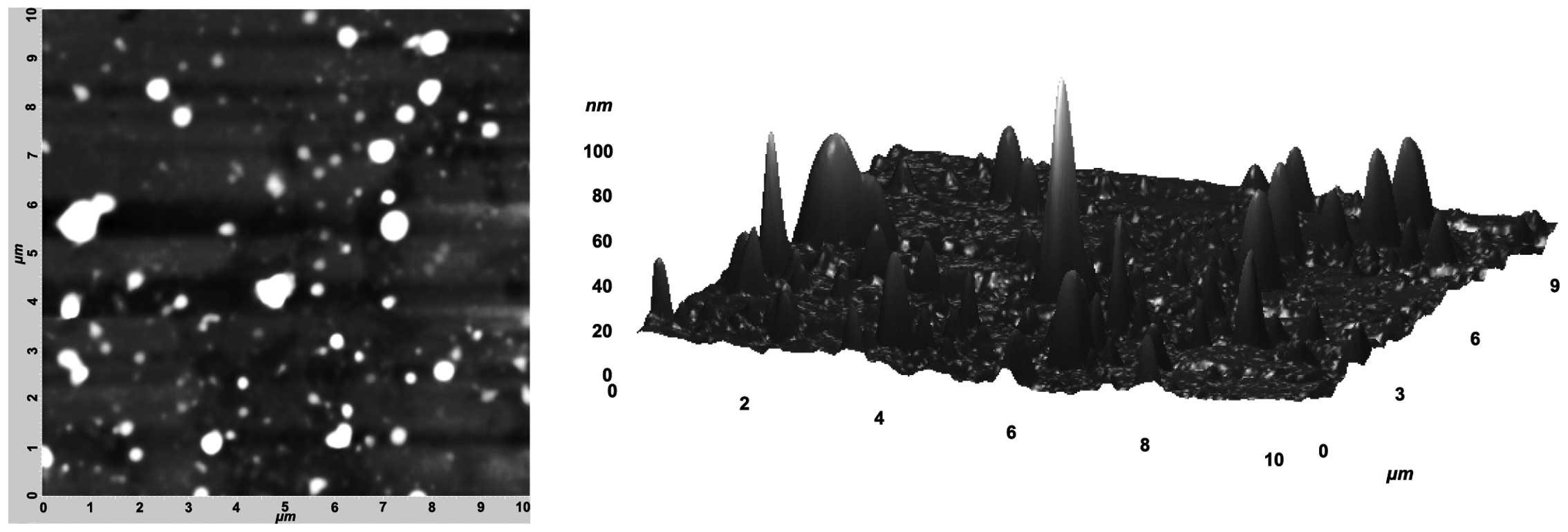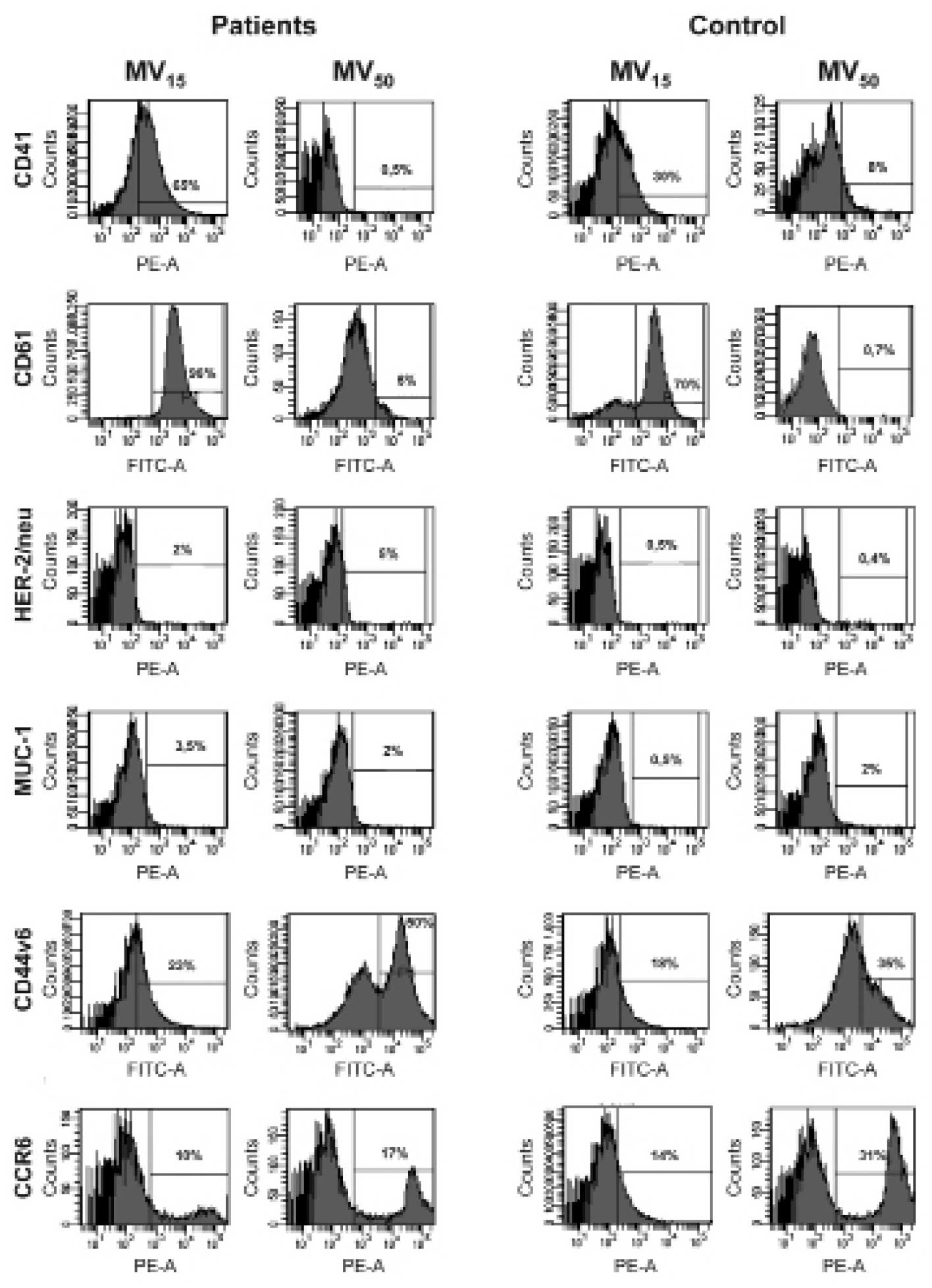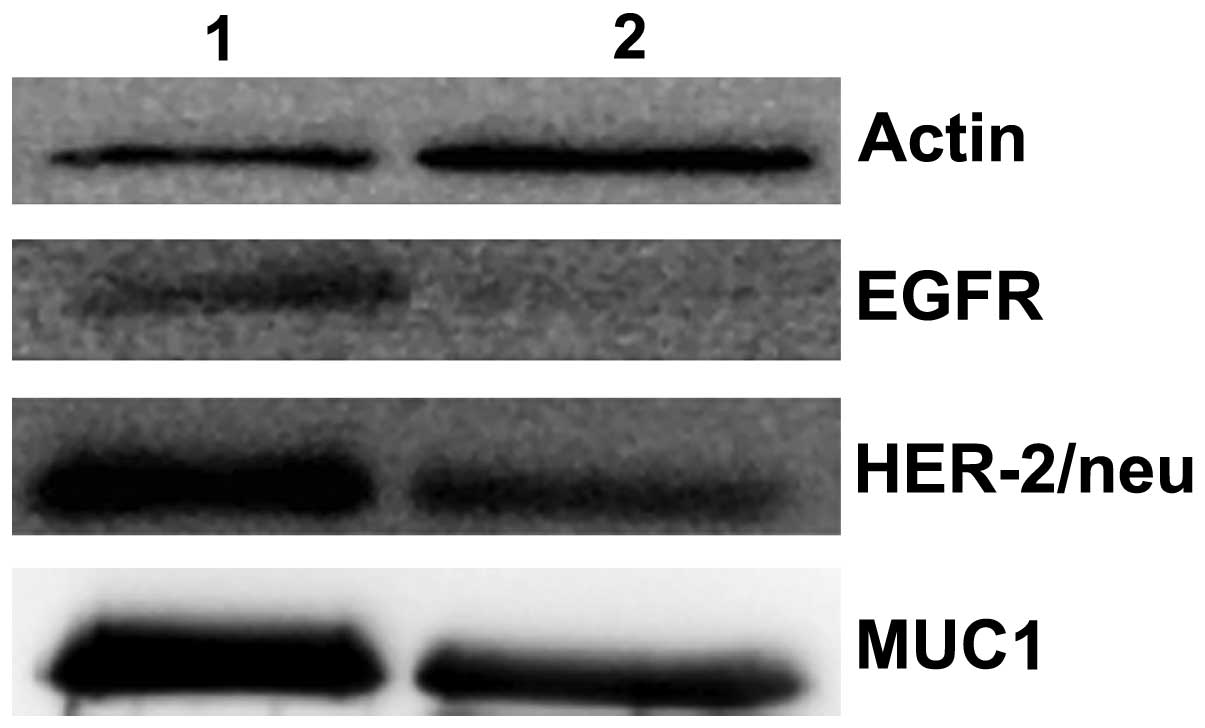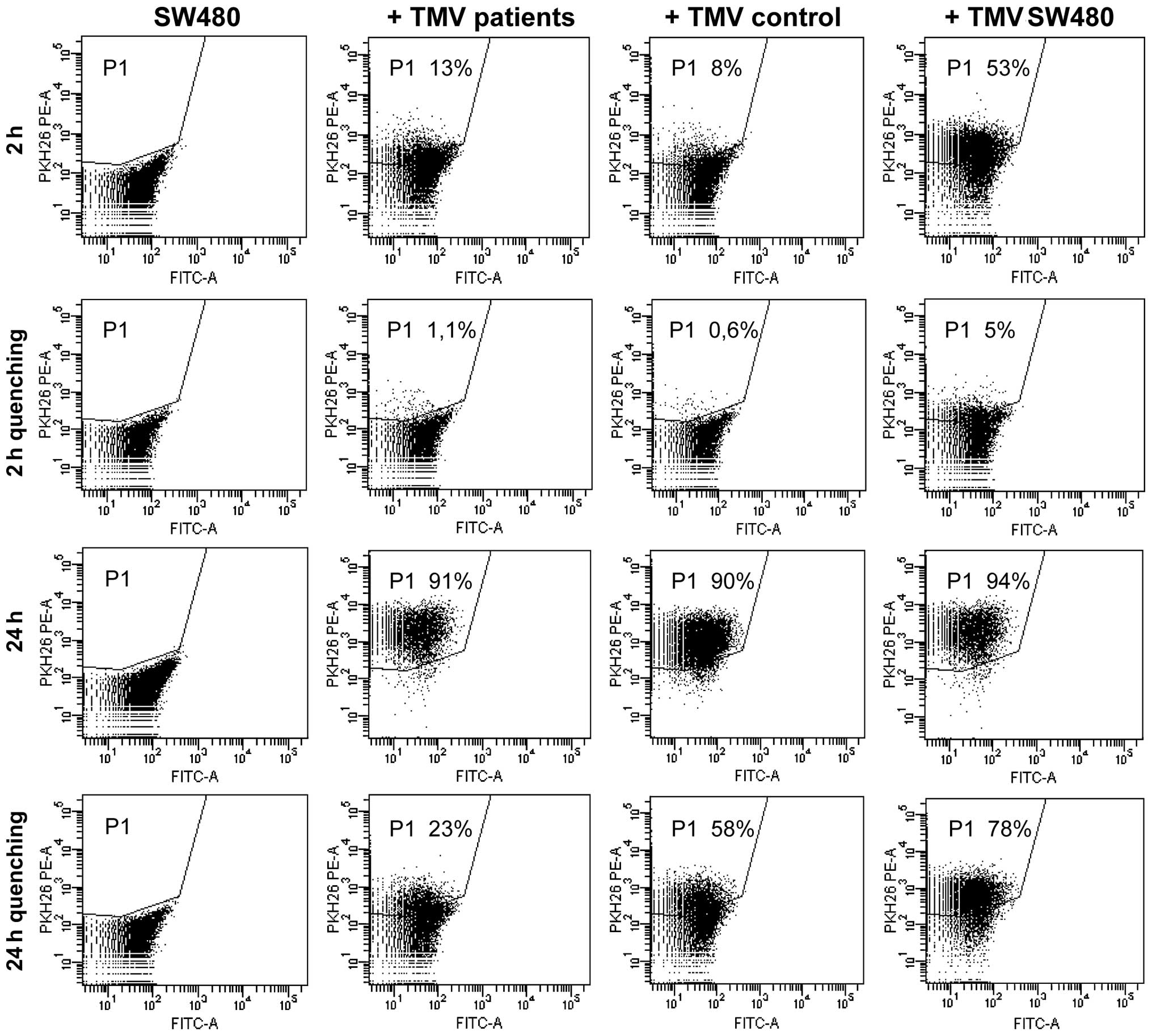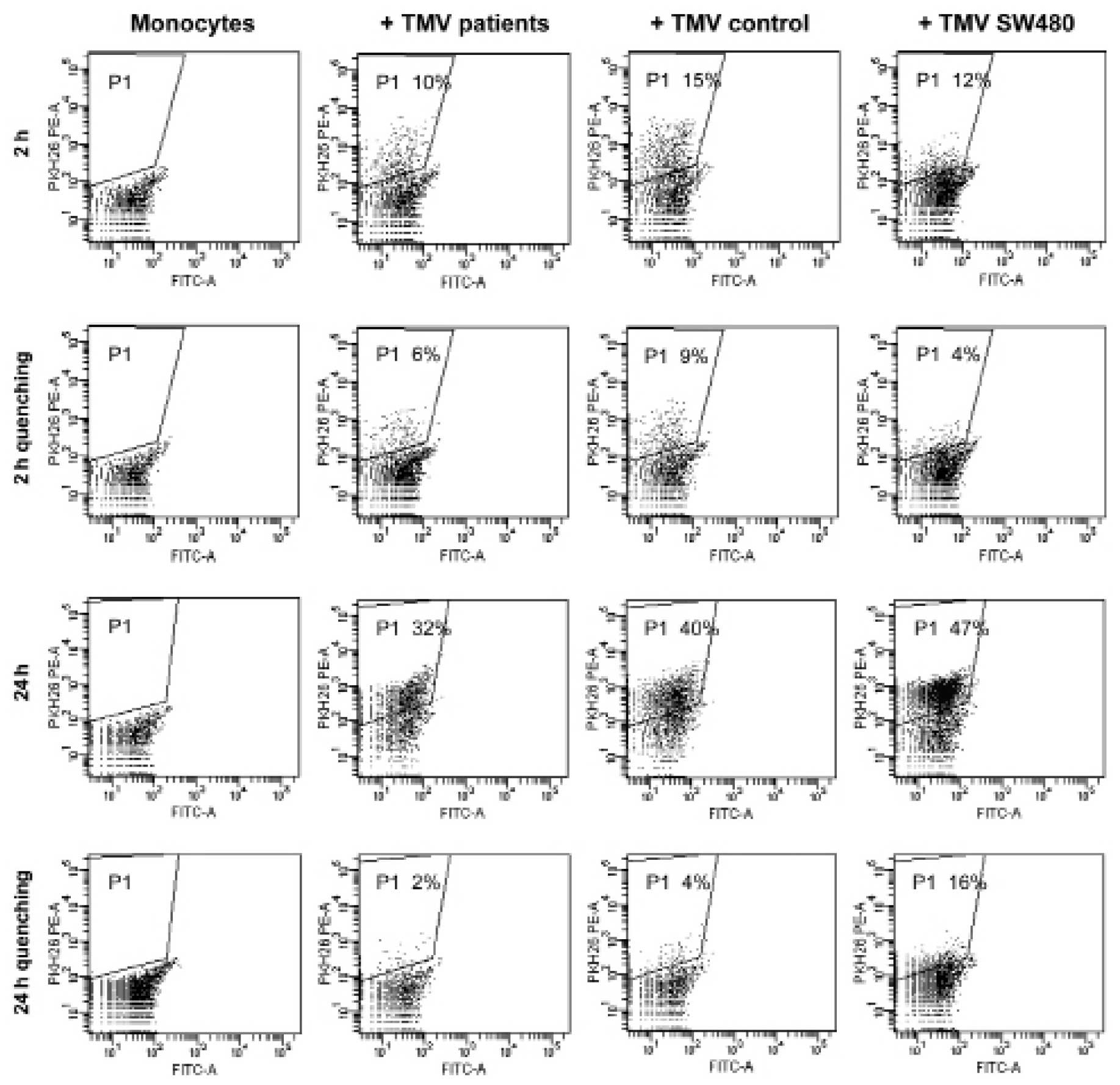Isolation and characterization of circulating micro(nano)vesicles in the plasma of colorectal cancer patients and their interactions with tumor cells
- Authors:
- Published online on: August 26, 2015 https://doi.org/10.3892/or.2015.4228
- Pages: 2768-2775
Abstract
Introduction
Micro(nano)particles, also known as micro(nano)vesicles (MV), have been the subject of extensive studies as they play an important role in cell-to-cell communication. In the present study, this traditional nomenclature was used, although in fact, MV are differently classified, usually according to size [exosomes, ectosomes, nanovesicles, micro(nano)particles, and extracellular vesicles], or function (oncosomes, argosomes, and tolerosomes) (1,2). The name 'vesicles' seems to be a misnomer as MV have different shapes and may be spherical, discoidal, elongated and cylindrical (3,4). MV are released by various cells and are present in body fluids, including blood, urine, pleural and cerebrospinal fluids, and ascites (1,3,4). The MV of tumor cells origin are classified as tumor-derived MV (TMV) (5).
The increased number of circulating MV of poorly defined origin was observed in patients with colorectal cancer (CRC) (6,7), gastric (8), ovarian (9), and breast (10) cancer, and some were indicated as possible predictors of progression. However, no evidence has been provided concerning whether TMV are also involved. We have previously found elevated numbers of HER-2/neu-positive MV in the platelet-free plasma of gastric cancer patients that were associated with advancement of the tumor, suggesting that some of these MV are TMV (3). Detection of TMV, among other MV, in blood may be of importance as they are regarded as biomarkers of cancer progression and may offer new diagnostic and therapeutic opportunities (1).
The present study was conducted to isolate MV from the plasma of CRC patients, known to demonstrate an enhanced level of MV (6) and healthy donors (control) to define their properties. Large plasma pools obtained from individual subjects were stepwise centrifuged at 15,000 x g and 50,000 x g and size, structure, immunophenotype, including some tumor markers, of MV obtained at each step were performed. Interactions of MV with cancer cells and monocytes were also studied. This study has shown that the circulating MV of CRC patients are heterogeneous in all these aspects. As some MV expressed tumor markers it seems to suggest that among them, TMV are also present.
Materials and methods
Patients
Circulating MV were studied in 98 patients with CRC (Duke's stages A-2, B-42, C-28, D-24 patients) and in control healthy volunteers (n=89). Blood was obtained from patients before any treatment and from control subjects by venous puncture and collected to EDTA-containing tubes (Vacutainer system; BD Biosciences, Franklin Lakes, NY, USA). To omit individual variations, large pools of plasma were formed by mixing 1 ml of plasma from individual subjects and were treated as representative for patients and control populations and used for the isolation of MV. These studies were approved by the Ethics Committee of the Jagiellonian University Medical College.
Cancer cells
The SW480 colon cancer cell line (courtesy of Professor Caroline Dive, Paterson Institute for Cancer Research, University of Manchester, UK) was used as the TMV source and their target. The cells were cultured in Dulbecco's modified Eagle's medium (DMEM) with high glucose content (PAA Laboratories GmbH, Pasching, Austria) supplemented with 10% of fetal bovine serum (FBS; Biowest, Nuaille, France), previously centrifuged at 50,000 x g for 1 h to remove bovine MV, at 37°C, in a 5% CO2 atmosphere and regularly tested for Mycoplasma sp. contamination using a PCR-ELISA kit (Roche, Mannheim, Germany) and for endotoxin contamination by the Limulus test (Charles River Laboratories, Wilmington, MA, USA) according to the manufacturer's instructions.
Isolation of MV
The MV were obtained by stepwise ultracentrifugation. Blood samples were centrifuged at 3,000 x g for 10 min to remove the cells. To omit individual variations, the obtained plasma (~1 ml each sample) were pooled and centrifuged at 15,000 x g for 15 min to obtain platelet-free plasma. Following the separation, the plasma contained ~2% while the pellet ~91% of CD61+ particles (3). The pellets obtained (called MV15) were suspended in serum-free medium and washed three times at 15,000 x g. The supernatants were then ultracentrifuged at 50,000 x g for 2 h. The MV pellets obtained (known as MV50) were resuspended in serum-free medium, washed three times at 50,000 x g and then resuspended in 0.15% NaCl solution (measurements of electrokinetic potential) or in the medium (other tests). The final suspensions were ~40 times concentrated. In some experiments, the supernatants from the SW480 cell line, were collected at confluency and TMVSW480 (prepared in the same manner), were used.
Determination of MV size distribution
The size of MV was determined in Zetasizer Nano ZS apparatus (Malvern Instruments Ltd., Malvern, UK) equipped with a laser of λ=633 nm, using the dynamic light scattering method (DLS), with a nominal measuring range of 0.6–6,000 nm. Fluctuations of light intensity due to Brownian's particle motions allowed determination of their average speed, which in turn was recalculated into effective particle size. The obtained values represented the radius of spherical particles, which moved in viscous media with the same velocity as the studied particles.
The ζ potential determination
Particle ζ potential was measured with the same Zetasizer Nano ZS apparatus (Malvern Instruments) for samples diluted 10 times in distilled water. Charged objects moving due to applied electric field altered the frequency of scattered light (Doppler effect), allowing determination of their electrophoretic mobility, which was recalculated to the ζ potential using the Smoluchowski equation.
Atomic force microscopy
Samples for atomic force microscopy (AFM) were prepared from isolated MV50 by adsorbing onto modified mica bases. The measurements were performed using an Ntegra Vita microscope (NT-MDT Co., Zelenograd, Russia). The AFM images were recorded using commercial silicon tip working in a tapping mode at a resonance frequency within a range of 140–240 kHz with a polysilicon cantilever (NT-MDT Co., Tempe, AZ, USA) of spring constants k=3.4 N/m or k=5.8 N/m.
Immunophenotyping of MV
To characterise the MV phenotype the following murine monoclonal antibodies (mAbs) were used: fluorescein isothiocyanate (FITC)-conjugated anti-CD44, -CD61, phycoerythrin (PE)-labelled anti-CD41, -CCR6 (chemokine receptor 6), -EGFR (epidermal growth factor receptor) (all from BD Pharmingen, San Diego, CA, USA) and FITC anti-CD44v6 (Bender MedSystems, Vienna, Austria), PE anti-MUC1 (Mucin1) (Santa Cruz Biotechnology, Inc., Santa Cruz, CA, USA) and anti-HER-2/neu Alexa Fluor 488-conjugated (BioLegend, San Diego, CA, USA). In parallel, staining with appropriate isotype-matched mouse IgG (BD Pharmingen, Bender MedSystems, Santa Cruz Biotechnology, Inc. or Biolegend) were used as negative controls. MV samples were incubated with mAbs for 30 min at 4°C, resuspended in 0.3 ml of PBS containing 0.1% sodium azide and analyzed by flow cytometry (FACS Canto), using FACS DiVa v. 5.1 software. After gating on FSC and SSC log scale, 50,000 events were acquired and statistical analysis was performed according to FITC, PE and Alexa Fluor 488 fluorescence of MV stained with isotype controls.
Western blotting
MV were lysed in M-PER lysing buffer (Pierce, Rockford, IL, USA) containing protease inhibitor cocktail (Roche). Isolated protein (20 µm) was mixed with NuPAGE LDS Sample Buffer (4X concentration) and NuPAGE Sample Reducing Agent (10X concentration) (both from Life Technologies, Carlsbad, CA, USA). Samples were heated (70°C, 10 min) and electrophoresed in 14% polyacryl-amide gel containing SDS. The samples were then transferred onto polyvinylidene fluoride membranes (Bio-Rad, Hercules, CA, USA). After blocking for 1 h at room temperature in Tris-buffered saline (TBS) with 0.1% Tween-20 and 1% bovine serum albumin (BSA) (both from Sigma-Aldrich, St. Louis, MO, USA) the membranes were incubated overnight at 4°C with murine mAbs against: EGFR (clone R-1), HER-2/neu (clone F-11), and rabbit anti-MUC1 (clone H-295) (all from Santa Cruz Biotechnology, Inc.) diluted 1:1,000. As a loading control, mouse anti-actin (clone C-2; Santa Cruz Biotechnology, Inc.) was used. After incubation, membranes were washed in TBS supplemented with BSA and Tween-20 and incubated for 1 h at room temperature with secondary goat anti-rabbit and anti-mouse antibodies (dilution at 1:4,000) conjugated with horseradish peroxidase (Santa Cruz Biotechnology, Inc.). The protein bands were visualized with the SuperSignal West Pico Chemiluminescence Substrate kit (Pierce) according to the manufacturer's instructions and analyzed with Kodak Gel Logic 1500 Digital Imaging system (Kodak, Rochester, NY, USA).
Binding and engulfment of TMV
To test the ability of TMV to bind to cancer cells and monocytes, TMV50 were stained with red PKH26 fluorescent dye (Sigma-Aldrich) for 5 min, according to the manufacturer's instructions and then incubated with SW480 cells and blood monocytes, isolated as previously described (11) (~2 TMV particles/cell, previously titrated as detectable by FACS), for 2 and 24 h. To discriminate between the cells which already engulfed TMV (intracellular localization) from those with TMV only attached to their surface (extracellular) a quenching assay with crystal violet (1 mg/ml final concentration; Sigma-Aldrich), added to the cell suspension (12), was introduced. In this assay the extracellular fluorescence was quenched by crystal violet (5). The samples were then analyzed by FACS. Gate P1 was set according to the autofluorescence of cells incubated in the medium without TMV.
Elimination of TMV from circulation
Severe combined immunodeficient (NOD SCID; Charles River Laboratories, Sulzfeld, Germany) mice (2/group) were injected intravenously into retroorbital veins with PKH26-labelled TMVSW480 (5×107 in 100 µl PBS/mouse). Handling and all the procedures were conductaed under laminar flow conditions. Blood was drawn from tail vein into EDTA-containing tubes at 5, 15, 30, 60 and 120 min after injection and then the mice were euthanized. Spleen, liver, lung and kidney were removed for further examination. Blood was centrifuged at 3,000 x g for 10 min and plasma and cells from the bottom were removed separately. Cells from the pellet were washed. Plasma was further centrifuged at 50,000 x g for 1 h and the pellet and plasma were analyzed for the presence of PKH26-labelled TMV by FACS. Organ samples were sectioned using Leica CM1850 cryostat (Leica Microsystems Nussloch GmbH, Nussloch, Germany). The presence of TMVSW480 was examined under the Olympus BX60 fluorescent microscope (Olympus Corp., Tokyo, Japan).
Results
Size distribution
The size of isolated MV15 and MV50, as defined by DLS, revealed heterogeneity and relatively small differences between them (Fig. 1). Broad distribution of sizes and rather high SD indicated polydispersity of samples. The size ranges were 70(80)–1,300(1,400) nm in MV15 and MV50 and no differences were observed between patients and controls. The most frequent number of particles had sizes 105 nm in MV15 and 70–90 nm in MV50, both in patients and control samples (differences were not significant). The negative ζ potential of MV15 from patients (−17.6±1.52 mV) and controls (−15.8±1.76 mV) did not differ, while the MV50 of patients had a significantly higher (P≥0.05) ζ potential (−16.8±0.90 mV) than that from the controls (−10.7±1.64 mV). AFM was used to investigate the structure of MV. It was not possible to analyze MV15 because of the presence of large homogenous clusters, which disturb the measurements. The MV50 isolated from the plasma of patients showed highly heterogeneous MV differing both in shapes and sizes (Fig. 2A and B). A comparison of sizes obtained from AFM and DLS showed their high compatibility. Immunophenotype was determined by flow cytometry and western blotting.
Expression of determinants and tumor markers
Among several determinants tested on MV by FACS, we concentrated on these of platelet origin (CD41, CD61), those involved in cancer cell interactions with other cells (CD44v6, CCR6) and tumor-associated (HER-2/neu, EGFR and MUC1). Expression of platelet markers (CD41, CD61) was significantly higher on MV15 than MV50, for patients and donors (Fig. 3) among which there was no difference. HER-2/neu-positive particles were more apparent in patients than donors, and in the former their proportion was higher in MV50 than MV15. Expression of MUC1 on MV15 was higher in patients but no difference between them was observed on MV50 protein content. The proportion of CD44v6 and CCR6 was higher on MV50 than MV15 but patients and controls showed no differences in their expression in MV15 and MV50. Western blot analysis of MV50 from the patients showed stronger bands of EGFR (HER-1/Erb B1), HER-2/neu and MUC1 as compared to the controls (Fig. 4).
Binding and ingestion by SW480 cells and monocytes of MV
Since MV are present at the tumor site (1), it was of interest to determine whether MV circulating in plasma are able to interact with cancer cells, i.e., whether MV are taken up by the cells. For this purpose, the cells from a colon cancer cell line (SW480) were exposed to PKH26-labelled MV50 (as enriched in MV of tumor cells origin) isolated from the plasma of patients and controls and TMVSW480 ('pure' TMV) for 2 and 24 h, followed by FACS analysis. After incubation for 2 h only a small proportion of MV50 was seen mostly extracellularly as judged by almost total quenching with crystal violet (Fig. 5). No difference was observed for MV50 between patients and donors, but TMVSW480 attachment was significantly higher (53%). Incubation for 24 h resulted in a significantly higher proportion of positive cells with or without quenching, indicating that approximately half of MV50 were localized intracellularly. This provides clear evidence for the attachment and engulfment of MV50 by cancer cells and indicated the lack of uptake specificity. The other noteworthy issue was the interaction of MV50 with monocytes. Monocytes were selected as the most common cell-infiltrating tumors (tumor-infiltrating monocytes, TIM). Monocytes were exposed to PKH26-labelled MV50, similarly for 2 and 24 h. Fig. 6 shows that uptake of MV50 from patients and control by monocytes occurred, and the proportion of positive cells was similar as observed in the case of cancer cells.
As the plasma level of circulating MV is relatively constant, the issue was whether it was due to elimination/delivery of MV. As the number of MV50 from patients and controls was extremely low to reach their level observed in human plasma, TMVSW480 were used to determine the elimination rate from blood and specific organ localization. Trace levels of PKH26-labelled TMVSW480 were detected in blood cells and plasma (~1.0% of injected) only at 5 min after intravenous injection into NOD SCID mice. At this time no labelled TMV in the liver, lung, spleen and kidney were detected. At 15 min after injection labelled TMVSW480 were observed in the liver and lung tissue sections, but not kidney and spleen. The highest fluorescence intensity was observed in the former. No TMV were detected later on in any of the examined organs. The results indicated that TMV were rapidly eliminated from blood and that the liver was mainly responsible for their 'trapping' and elimination.
Discussion
Many micro(nano)particles, also known as microvesicles (MV), are released by tumor cells (TMV). TMV play a pivotal role in cancer and may serve as a putative diagnostic tool and therapeutic target (1). However, MV are also shed by many cells of the body (e.g., platelets, hepatocytes, endothelium), including those present in tumor stroma (13). MV circulating in blood are of different cell origin. Their level is increased in many types of cancer (3,8–10). Detection of circulating TMV (oncosomes) in blood is limited by the fact that their estimated frequency among host MV is approximately 1% (1). Since most common platelet-derived MV (CD41+, CD61+) attenuate TMV, the studies were undertaken to remove them from the plasma of CRC patients. Our previous observation in gastric cancer patients indicated that plasma centrifugation at 15,000 x g led to the substantial depletion of MV of platelet origin (3). In the present study, stepwise centrifugation of plasma at 15,000 x g and 50,000 x g was used to characterize more precise fractions obtained at these gravities, known as MV15 and MV50, respectively. Using these fractions we characterized MV size, electrokinetic potential, morphology, expression of tumor markers, and MV50 interactions in vitro with cancer cells and monocytes.
Different methods are used for determination of MV size, e.g., electron microscopy, DLS (3) or AFM, alone or combined with microfluidics (14,15). We used the DLS method and found an almost identical range of sizes (70–1,400 nm) among MV15 and MV50 fractions, both in patients and controls. From the size distribution of nanoparticles it appears that MV15, from patients and control were more heterogeneous (trimodal pattern) while MV50 showed a bimodal size distribution. The most common frequency of particle size in MV15 was approximately 105 nm, while in MV50 80–90 nm. This size suggesta that most MV are equivalent to exosomes (16). DLS results are in concordance with data from the AFM analysis, which indicated a similar mean range of sizes, and different shapes of MV50. There was no difference between patients and control samples (not shown). In comparison to MV15 the MV50 of CRC patients exhibited an increased expression of some tumor markers, mainly HER-2/neu, MUC1 as defined by flow cytometry and EGFR (HER-1/Erb B1), HER-2/neu and MUC1 as determined by western blotting. The level of CD44v6 and CCR6 was also higher in MV50 than MV15 but no differences between patients and control were identified. The general conclusion was that MV50 from patients contained more TMV, i.e., expressing tumor markers as compared to the controls and MV15. This finding can be extrapolated to suggest that in patients, tumor marker positive circulating MV50 are present in elevated numbers. Since the two markers are overexpressed in colon cancer cells (17,18), it appears to indicate that CRC tumors are the major source of such MV, i.e., TMV. The presence of HER-2/neu and MUC1 in healthy individuals is not noteworthy as normal colon epithelial cells also express at least HER-2/neu (19), while MUC1 is not a truly specific tumor marker (20). It is notable that EGFR on MV50 was detected by western blotting but not by FACS. The likely explanation may be that it is not expressed on the MV50 surface, but present inside only. This is in agreement with the observation that SW480 cells are EGFR-positive, while EGFR is not detected on TMVSW480 (unpublished observation). The higher ζ potential of patients' MV50, may also be associated with the presence of MV of tumor origin.
As MV of tumor and tumor-infiltrating cells origin are observed in the tumor bed (21–23), we determined whether MV50 present in plasma may interact with cancer cells. Colon cancer cells (SW480) were used as a target for MV50 from patients and controls. SW480 cells were exposed to PKH-26-labelled MV50 from plasma and TMVSW480 as controls. At 2 h the MV attached to the cells, while at 24 h engulfment occurred. There was no significant difference in the magnitude of the MV uptake, thus indicating a lack of specificity in interactions of MV with cancer cells. Uptake of tumor-derived exosomes i.e., with particles sizes <100 nm has already been described (24,25). However, these small MV were isolated from supernatants of culture cell lines (24–26). Thus, to the best of our knowledge, the present results are the first to demonstrate that circulating ('native') MV can also interact with cancer cells. Although some specificity of tumor-derived exosomes towards cancer cells over 'immortalized' cells was suggested, such exosomes are not preferentially associated with their parental cell lines (16). The lack of specificity may be due to various endocytic pathways of uptake, not only exosomes, but also 'native MV' (25,26). Uptake of plasma MV by cancer cells indicate that such MV, such as TMV, may deliver their cargo to target cells (5). Since TMV are considered a potential drug delivery means (1), the lack of specificity in uptake of MV50 may be advantageous as isolation of circulating MV from healthy subjects is relatively simple, as shown in the present study. Additionally, it is unlikely that MV of tumor origin may deliver 'unwanted' cargo. Uptake of plasma MV by monocytes may also be involved in their delivery to the tumor site, as monocytes are prominent participants of the tumor infiltrate (27,28).
It was noteworthy to identify where TMV are accumulated in the body and the expeditious manner in which they are eliminated. These studies were undertaken in NOD SCID mice which were infused with 'pure' TMVSW480 labelled with fluorescent dye PKH-26 in numbers required to reach the level of total MV observed in the blood of patients. No presence of these TMV in blood cells was observed 5 min after injection, suggesting their rapid elimination. At 15–30 min, their accumulation was observed mostly in the liver, and lungs. The finding suggests that TMV are taken up by tissue macrophages (abundantly present in these organs), which is supported by observations that TMV were attached to human blood monocytes in vitro within 2 h and then engulfed within 24 h (unpublished). However, we were unable to establish the sequence of subsequent intracellular events, as at latter times TMV were not identified in these organs, e.g., possible degradation by enzymes for which there is an abundance in macrophages (29). However, these findings suggest that continuous delivery of MV is necessary in the body because their continuous level was detected.
In conclusion, this study provides evidence for the heterogeneity in many respects of circulating MV in CRC patients, some of which are likely to be of tumor origin. These MV may affect the tumor and may be carried by monocytes. However, their precise role in this type of cancer remains unclear and requires additional studies.
Acknowledgments
We would like to thank Ms. I Ruggiero for skillful technical assistance. Grant sponsors included the National Science Centre (grant no. N N401 290239). Publication of this study was supported by the Leading National Research Center (KNOW), Faculty of Medicine, Jagiellonian University Medical College.
References
|
Rak J: Extracellular vesicles - biomarkers and effectors of the cellular interactome in cancer. Front Pharmacol. 4:212013. View Article : Google Scholar : PubMed/NCBI | |
|
Choi DS, Kim DK, Kim YK and Gho YS: Proteomics of extracellular vesicles: Exosomes and ectosomes. Mass Spectrom Rev. 34:474–490. 2015. View Article : Google Scholar | |
|
Baran J, Baj-Krzyworzeka M, Węglarczyk K, Szatanek R and Zembala M, Barbasz J, Czupryna A, Szczepanik A and Zembala M: Circulating tumour-derived microvesicles in plasma of gastric cancer patients. Cancer Immunol Immunother. 59:841–850. 2010. View Article : Google Scholar : PubMed/NCBI | |
|
Mrvar-Brecko A, Sustar V, Jansa V, Stukelj R, Jansa R, Mujagić E, Kruljc P, Iglic A, Hägerstrand H and Kralj-Iglic V: Isolated microvesicles from peripheral blood and body fluids as observed by scanning electron microscope. Blood Cells Mol Dis. 44:307–312. 2010. View Article : Google Scholar : PubMed/NCBI | |
|
Baj-Krzyworzeka M, Szatanek R, Węglarczyk K, Baran J, Urbanowicz B, Brański P, Ratajczak MZ and Zembala M: Tumour-derived microvesicles carry several surface determinants and mRNA of tumour cells and transfer some of these determinants to monocytes. Cancer Immunol Immunother. 55:808–818. 2006. View Article : Google Scholar | |
|
Silva J, Garcia V, Rodriguez M, Compte M, Cisneros E, Veguillas P, Garcia JM, Dominguez G, Campos-Martin Y, Cuevas J, et al: Analysis of exosome release and its prognostic value in human colorectal cancer. Genes Chromosomes Cancer. 51:409–418. 2012. View Article : Google Scholar : PubMed/NCBI | |
|
Choi DS, Yang JS, Choi EJ, Jang SC, Park S, Kim OY, Hwang D, Kim KP, Kim YK, Kim S, et al: The protein interaction network of extracellular vesicles derived from human colorectal cancer cells. J Proteome Res. 11:1144–1151. 2012. View Article : Google Scholar | |
|
Kim HK, Song KS, Park YS, Kang YH, Lee YJ, Lee KR, Kim HK, Ryu KW, Bae JM and Kim S: Elevated levels of circulating platelet microparticles, VEGF, IL-6 and RANTES in patients with gastric cancer: Possible role of a metastasis predictor. Eur J Cancer. 39:184–191. 2003. View Article : Google Scholar : PubMed/NCBI | |
|
Giusti I, D'Ascenzo S and Dolo V: Microvesicles as potential ovarian cancer biomarkers. Biomed Res Int. 2013:7030482013. View Article : Google Scholar : PubMed/NCBI | |
|
Galindo-Hernandez O, Villegas-Comonfort S, Candanedo F, González-Vázquez MC, Chavez-Ocaña S, Jimenez-Villanueva X, Sierra-Martinez M and Salazar EP: Elevated concentration of microvesicles isolated from peripheral blood in breast cancer patients. Arch Med Res. 44:208–214. 2013. View Article : Google Scholar : PubMed/NCBI | |
|
Mytar B, Baran J, Gawlicka M, Ruggiero I and Zembala M: Immunophenotypic changes and induction of apoptosis of monocytes and tumour cells during their interactions in vitro. Anticancer Res. 22:2789–2796. 2002. | |
|
Van Amersfoort ES and Van Strijp JA: Evaluation of a flow cytometric fluorescence quenching assay of phagocytosis of sensitized sheep erythrocytes by polymorphonuclear leukocytes. Cytometry. 17:294–301. 1994. View Article : Google Scholar : PubMed/NCBI | |
|
Luga V and Wrana JL: Tumor-stroma interaction: Revealing fibroblast-secreted exosomes as potent regulators of Wnt-planar cell polarity signaling in cancer metastasis. Cancer Res. 73:6843–6847. 2013. View Article : Google Scholar : PubMed/NCBI | |
|
Ashcroft BA, de Sonneville J, Yuana Y, Osanto S, Bertina R, Kuil ME and Oosterkamp TH: Determination of the size distribution of blood microparticles directly in plasma using atomic force microscopy and microfluidics. Biomed Microdevices. 14:641–649. 2012. View Article : Google Scholar : PubMed/NCBI | |
|
Yuana Y, Oosterkamp TH, Bahatyrova S, Ashcroft B, Garcia Rodriguez P, Bertina RM and Osanto S: Atomic force microscopy: A novel approach to the detection of nanosized blood microparticles. J Thromb Haemost. 8:315–323. 2010. View Article : Google Scholar | |
|
Smyth TJ, Redzic JS, Graner MW and Anchordoquy TJ: Examination of the specificity of tumor cell derived exosomes with tumor cells in vitro. Biochim Biophys Acta. 1838:2954–2965. 2014. View Article : Google Scholar : PubMed/NCBI | |
|
Yang JL, Hanley JR, Yu Y, Berney CR, Russell PJ and Crowe PJ: In vivo overexpression of c-erbB-2 oncoprotein in xenografts of mice implanted with human colon cancer lines. Anticancer Res. 17:3463–3468. 1997.PubMed/NCBI | |
|
Yu Z, Cui B, Jin Y, Chen H and Wang X: Novel irreversible EGFR tyrosine kinase inhibitor 324674 sensitizes human colon carcinoma HT29 and SW480 cells to apoptosis by blocking the EGFR pathway. Biochem Biophys Res Commun. 411:751–756. 2011. View Article : Google Scholar : PubMed/NCBI | |
|
Cohen JA, Weiner DB, More KF, Kokai Y, Williams WV, Maguire HC Jr, LiVolsi VA and Greene MI: Expression pattern of the neu (NGL) gene-encoded growth factor receptor protein (p185neu) in normal and transformed epithelial tissues of the digestive tract. Oncogene. 4:81–88. 1989.PubMed/NCBI | |
|
Labouvie C, Machado J, Carneiro F, Seitz G and Blin N: Expression pattern of gastrointestinal markers in native colorectal epithelium, lesions, and carcinomas. Oncol Rep. 4:1367–1371. 1997.PubMed/NCBI | |
|
Gromov P, Gromova I, Olsen CJ, Timmermans-Wielenga V, Talman ML, Serizawa RR and Moreira JM: Tumor interstitial fluid - a treasure trove of cancer biomarkers. Biochim Biophys Acta. 1834:2259–2270. 2013. View Article : Google Scholar : PubMed/NCBI | |
|
Yang M, Chen J, Su F, Yu B, Su F, Lin L, Liu Y, Huang JD and Song E: Microvesicles secreted by macrophages shuttle invasion-potentiating microRNAs into breast cancer cells. Mol Cancer. 10:1172011. View Article : Google Scholar : PubMed/NCBI | |
|
Dayan D, Salo T, Salo S, Nyberg P, Nurmenniemi S, Costea DE and Vered M: Molecular crosstalk between cancer cells and tumor microenvironment components suggests potential targets for new therapeutic approaches in mobile tongue cancer. Cancer Med. 1:128–140. 2012. View Article : Google Scholar | |
|
Tian T, Wang Y, Wang H, Zhu Z and Xiao Z: Visualizing of the cellular uptake and intracellular trafficking of exosomes by live-cell microscopy. J Cell Biochem. 111:488–496. 2010. View Article : Google Scholar : PubMed/NCBI | |
|
Escrevente C, Keller S, Altevogt P and Costa J: Interaction and uptake of exosomes by ovarian cancer cells. BMC Cancer. 11:1082011. View Article : Google Scholar : PubMed/NCBI | |
|
Feng D, Zhao WL, Ye YY, Bai XC, Liu RQ, Chang LF, Zhou Q and Sui SF: Cellular internalization of exosomes occurs through phagocytosis. Traffic. 11:675–687. 2010. View Article : Google Scholar : PubMed/NCBI | |
|
Leek RD, Lewis CE, Whitehouse R, Greenall M, Clarke J and Harris AL: Association of macrophage infiltration with angiogenesis and prognosis in invasive breast carcinoma. Cancer Res. 56:4625–4629. 1996.PubMed/NCBI | |
|
Mantovani A, Sozzani S, Locati M, Allavena P and Sica A: Macrophage polarization: Tumor-associated macrophages as a paradigm for polarized M2 mononuclear phagocytes. Trends Immunol. 23:549–555. 2002. View Article : Google Scholar : PubMed/NCBI | |
|
Zembala M and Buckle AM: Monocytes in malignant disease. Human Monocytes. Zembala M and Asherson GL: Academic Press; London: pp. 513–528. 1989 |



